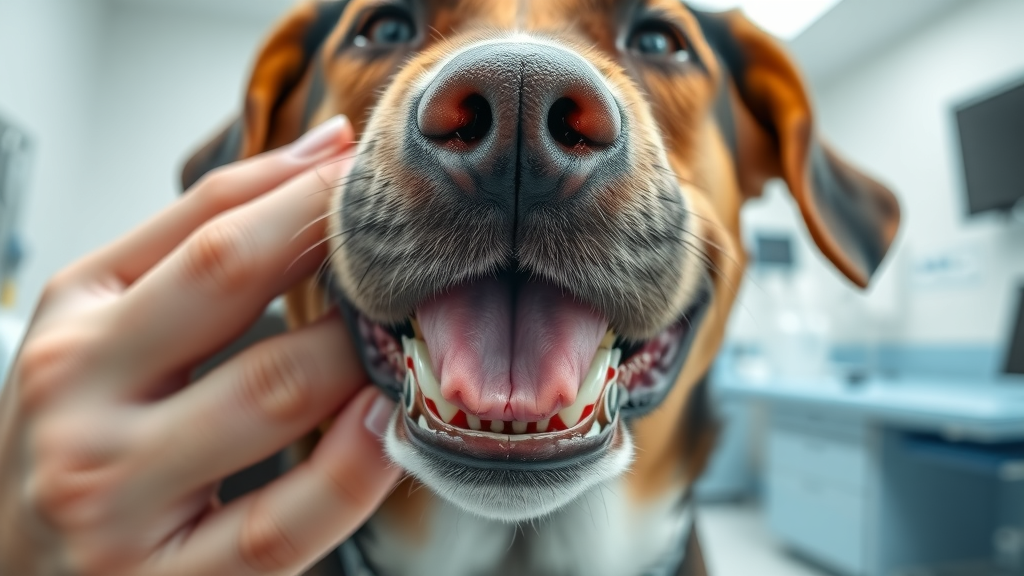Ever wondered if you’d spot the earliest hints your furry friend isn’t feeling well? As a dedicated pet parent, you know your dog best—yet sickness can hide behind the wag of a tail or a stretched yawn. This guide reveals the most important clues to answer “what are signs my dog is sick?” so you can act fast, keep your dog comfortable, and avoid medical emergencies. Read on for the warning signs, expert tips, and smart next steps—because your dog’s health depends on your vigilance.
Is Your Dog Showing Subtle Signs of Illness? An In-Depth Look at What Are Signs My Dog Is Sick?
When pet parents ask, “what are signs my dog is sick?” they’re already taking a crucial step toward protecting their dogs’ wellbeing. Dogs are experts at hiding discomfort, often masking their distress by acting normally until their illness worsens. That’s why knowing both subtle and obvious signs of illness is so important. Sometimes, what seems like a minor quirk—less wagging, more naps, or skipped meals—can be an early red flag. By learning and responding to these signals, you can prevent small health issues from snowballing into emergencies.
Imagine noticing your once-playful dog suddenly seems uninterested in favorite toys, ignores dinner, or sleeps far more than usual. Perhaps you spot pale gums while cuddling, or hear an uncommon cough after a trip to the park. Each of these changes can be a common sign of various health problems, from digestive issues and infections to heart failure or kidney disease. In the next sections, we’ll break down these warning signs, focusing on how pain, behavior, and physical symptoms reveal that something might not be right with your beloved pet.
"Dogs often mask their discomfort—learning to spot the early signs of illness is key to keeping your companion healthy and happy."
- Key answers to what are signs my dog is sick?
- Insight into common signs indicating a dog is sick
- How pain in dogs and behavioral changes reveal sickness
- When symptoms point to a decline in quality of life
- Steps to respond if your dog is sick

Understanding What Are Signs My Dog Is Sick? Recognizing the Early Warnings
Early detection can make a world of difference for your dog’s health. The signs of illness in dogs often start with behaviors or physical changes that seem small but signal underlying health issues. Whether your dog is a lively puppy or a wise senior, these warning signs shouldn’t be ignored. Start by observing appetite changes, unusual lethargy, or sudden vomiting, which often indicate an upset stomach or something much more serious such as kidney disease or a bacterial infection.
A responsible pet parent will also notice more subtle cues: maybe your dog hides instead of greeting visitors or pants heavily even at rest. These changes are your clues—they signal when it’s time to talk to your vet, monitor symptoms closely, and take preventive steps. Utilize the table below to familiarize yourself with the most common and most critical red flags that answer the pressing question, “ what are signs my dog is sick? ”
| Red Flag | Description |
|---|---|
| Loss of appetite | Refusing food or treats |
| Lethargy | Less active than usual |
| Vomiting/Diarrhea | Frequent, persistent vomiting or loose stools |
| Coughing | Persistent cough, especially kennel cough signs |
| Trouble breathing | Rapid, shallow, or noisy breathing |
| Pale gums | Gums appear white, blue, or pale yellow |
| Sudden weight loss | Dramatic, unexplained drop in weight |
| Behavioral change | Hiding, aggression, or clinginess |
Common Signs Your Dog Is Sick: What Are Signs My Dog Is Sick? Every Owner Should Know
Identifying illness early hinges on recognizing both obvious and subtle common signs . Some symptoms—like a loss of appetite or sudden weight loss —stand out immediately, often linked to serious health issues such as kidney disease or metabolic disorders. Lethargy, frequent vomiting, or diarrhea shouldn’t be dismissed as “just a bad day”; instead, these can point to deeper health issues requiring veterinary care.
Meanwhile, other symptoms like persistent coughing (possibly kennel cough), difficulty breathing , or pale gums can indicate serious emergencies, including heart failure or severe infections. Sometimes, a behavioral change —hiding, unusual aggression, or clinginess—can be the only clue that your dog is sick, especially if there are no obvious physical changes. Being attentive to these warning signs and seeking prompt veterinary advice could save your dog’s life.
- Loss of appetite
- Sudden weight loss
- Lethargy and listlessness
- Frequent vomiting or diarrhea
- Persistent coughing (potential kennel cough)
- Difficulty breathing or abnormal panting
- Pale gums and other gum color changes
- Behavioral changes such as hiding or aggression

Loss of Appetite and Weight Loss: Core Answers to 'What Are Signs My Dog Is Sick?'
A noticeable loss of appetite , especially when your dog refuses once-cherished treats or wet food, is a classic signal something is wrong. Over several days, skipping meals often leads to weight loss —another key sign your dog may be suffering from health issues like gastrointestinal upset, dental disease, or even organ dysfunction such as kidney disease. Don’t assume your dog is just being picky; persistent changes in eating habits deserve a prompt appointment with your vet.
Unexpected weight loss, combined with tiredness or vomiting, can point to chronic illnesses or even major medical conditions, like diabetes, parasites, or cancer. Monitoring your dog’s eating patterns and body condition helps you catch these problems before they escalate. Remember, steady weight loss is never normal in healthy dogs and should always prompt a conversation with your trusted veterinarian.
Trouble Breathing and Kennel Cough: Distinguishing Dangerous Symptoms
Rapid, shallow, or noisy breathing—also known as trouble breathing —is never normal. Difficulty breathing can be a sign of health problems such as heart failure, lung disease, or even poisoning and demands immediate veterinary attention. Coughing, especially when it’s persistent or hacking, may point to kennel cough (a contagious respiratory infection) or underlying cardiac issues. These symptoms are not only uncomfortable for your dog but can quickly become life-threatening if left unaddressed.
If you hear gurgling, high-pitched whistle, or choking sounds, your sick dog needs to see a vet as soon as possible. Pay close attention to any behavior changes that accompany these symptoms, such as restlessness, blue or pale gums, or collapse. Always trust your instincts: if breathing seems difficult, act fast and seek veterinary care.
Recognizing Pain in Dogs: What Are Signs My Dog Is Sick?
Pain in dogs isn’t always obvious. Your dog might not cry out or whimper—instead, you’ll see more subtle clues. Whining, reluctance to play, or even adopting unusual postures can all signal discomfort. Sometimes, you’ll notice restlessness or that your dog keeps shifting position, unable to get comfortable. These signs may be caused by anything from arthritis or abdominal pain to hip dysplasia or trauma.
Sensitivity to touch, sudden protectiveness over a certain body part, or chewing and licking one area repeatedly are classic indicators that your dog is experiencing pain. In many cases, early intervention—especially for chronic pain conditions or injuries—improves your dog’s quality of life dramatically. Watch for these behaviors and report them during your next appointment with your vet, especially if you suspect a hidden health problem.
- Whining or yelping
- Reluctance to move or play
- Restlessness or repeated shifting
- Sensitivity to touch or guarding a body part
- Licking or chewing a sore area
"Even subtle changes in your dog's behavior can be an early warning of underlying pain or illness."
Changes in Behavior: Emotional Clues to What Are Signs My Dog Is Sick?
Behavioral changes in dogs can be as important as physical symptoms when decoding what are signs my dog is sick. Emotional shifts often come before clear physical signs, especially with chronic illnesses or pain. For instance, a typically clinging dog who starts hiding in corners, or a social pup who growls at gentle touch, is speaking volumes about their discomfort. These clues are especially critical in senior dogs , as they are more prone to health issues that impact their emotional wellbeing and quality of life .
Notice if your dog is suddenly glued to your side (clinginess), hiding out of sight, or showing unexplained aggression or irritability. Such shifts often mean your dog feels unwell or anxious due to a developing medical condition. Emotional clues should never be ignored , as they offer early identification opportunities—especially for illnesses that haven’t yet produced outward symptoms.

From Playful to Withdrawn: Behavior Shifts as Warning Signs
The transition from a joyful, playful personality to withdrawal or defensiveness is a common sign your dog is sick. Dogs that usually greet you with a wagging tail but now avoid eye contact or seem apprehensive are giving clear signals. Behavioral red flags are your chance to intervene early—sometimes before even your vet can spot a problem.
- Increased aggression or irritability
- Unexplained fearfulness or hiding
- Sudden clinginess or neediness

How Quality of Life Changes Can Signal Your Dog Is Sick
Declining quality of life —such as less play, reduced appetite, or unwillingness to socialize—can be a major warning that your dog is dealing with a chronic or acute illness. Compare your dog’s typical behaviors with recent trends. Dogs who once eagerly chased balls but now nap through playtime, or who withdraw from the family, are telling you they’re not ok. Assess these changes regularly , especially in senior dogs , where arthritis, cancer, or organ disease are more common. Below is a table to help you differentiate healthy versus ailing dogs:
| Indicator | Healthy Dog | Sick Dog |
|---|---|---|
| Playfulness | High | Low or absent |
| Appetite | Good | Decreased or non-existent |
| Mobility | Normal, active | Limping, reluctance to move |
| Social behavior | Engaged, interactive | Withdrawn, isolated |
Spotting Red Flags in Senior Dogs: Unique Concerns in 'What Are Signs My Dog Is Sick?'
Senior dogs bring unique challenges for pet parents. As they age, subtle changes can signal emerging health problems. Sudden confusion or seeming “zoned out,” having accidents indoors after years of being house-trained, or changes in sleep habits all suggest medical issues that are commonly missed in older dogs. Many of these symptoms are due to age-related illnesses such as kidney disease, canine cognitive dysfunction, or arthritis—but don’t assume slow movements or forgetfulness are simply getting older.
Loss of mobility, stiffness, and an unwillingness to rise from lying down are often signs of pain, especially from conditions like arthritis, hip dysplasia, or even hidden injuries. Watch closely for these signs, as early intervention can help maximize your senior dog’s comfort, happiness, and quality of life . Talking to your vet about supplements, pain management, and appropriate exercise can offer real improvements.
- Sudden confusion or disorientation
- Incontinence or indoor accidents
- Noticeable changes in sleep patterns
- Loss of mobility or stiffness

Noticing Pale Gums and Gum Color Changes When Asking 'What Are Signs My Dog Is Sick?'
A quick look inside your dog’s mouth can provide a crucial clue to overall health. Pale gums or gums that appear white, blue, or yellow often mean a major health issue is present. Checking gum color regularly allows for the early identification of hidden illnesses—especially during bouts of vomiting, lethargy, or weakness.
Pale Gums: What They Indicate About Sickness in Dogs
Pale gums can signal anemia from blood loss, internal bleeding, shock, or severe infections. In some cases, pale gums are linked to heart failure or organ dysfunction—a true medical emergency. If your dog’s gums look unusually light, blue, or gray, call your vet immediately. It’s also vital to check if your dog’s tongue or inner eyelids look pale, another subtle sign of a sick dog.
Other Critical Mouth and Gum Symptoms
Beyond pale gums, note any gum swelling, foul breath, ulcers, or excessive drooling. These could point to dental disease, bacterial infection, or kidney disease—a major cause of mouth changes in dogs. Unaddressed, these symptoms can lead to systemic problems, risking your dog’s health and comfort. Always mention mouth and gum changes during any appointment with your vet to ensure nothing is overlooked.

Difficulty Breathing as a Major Warning in What Are Signs My Dog Is Sick?
Difficulty breathing is a medical emergency and demands immediate veterinary evaluation. Heavy, open-mouth breathing, gasping, or any new noise while breathing can mean major heart, lung, or airway problems. Check your dog for additional red flags like blue or gray gums, lethargy, or collapse, all pointing toward a critical health issue such as congestive heart failure or a severe asthma attack.
Rapid breaths, especially at rest, or signs of distress like pacing and wide-eyed panic mean your sick dog is unable to get enough oxygen. The cause could range from pneumonia and allergic reactions to heatstroke or toxins. In these situations, skip home remedies and contact your vet without delay; every minute counts for your dog’s life. Remember, trouble breathing is never “normal” and always warrants an urgent response.
- Rapid or shallow breaths
- Labored, noisy, or open-mouth breathing
- Blue, pale, or grayish gums

Kidney Disease, Vomiting, and Diarrhea: Are These Signs My Dog Is Sick?
Repeated vomiting and diarrhea not only cause rapid weight loss but can signal threats like poisoning, infection, or kidney disease . An increase in thirst and urination, coupled with bad breath that smells like chemicals or ammonia, is a classic combination for kidney trouble. Lethargy often goes hand in hand, as toxins build up in the body, affecting overall quality of life .
In these cases, talk to your vet immediately to prevent dehydration, shock, or organ damage. Early treatment often means simpler solutions and far less distress for your dog. Keep notes on all episodes—frequency, timing, color, and any unusual symptoms—to help your vet make the quickest, most accurate diagnosis for your sick dog.
- Excessive thirst and urination
- Vomiting or diarrhea
- Bad breath with chemical or ammonia odor
- Weight loss and lethargy

When to Seek Help: Responding to What Are Signs My Dog Is Sick?
Delaying treatment can make a simple health issue into a full-blown crisis. Pet parents should seek veterinary care as soon as red flags like pale gums , trouble breathing , persistent vomiting, or pronounced behavioral change arise. Track all symptoms, never give over-the-counter medications without advice, and isolate your dog from other pets if you suspect kennel cough or another contagious illness. Access to water and a cozy, quiet space are crucial until you can see your vet. Remember, swift action is the best way to protect your dog’s health and maintain a good quality of life.
- Monitor symptoms and take notes
- Contact your veterinarian promptly
- Avoid over-the-counter medications
- Isolate your pet if contagious illness is suspected
- Ensure access to water and comfort
"Early intervention can make the difference between a minor problem and a serious emergency for your dog."
Watch this comprehensive visual guide to better understand the visible and subtle signs that a sick dog might show. From pale gums to changes in behavior, this video helps you identify and respond to illness before it worsens.
People Also Ask: Expert Answers on What Are Signs My Dog Is Sick?
How can you tell if your dog is unwell?
- Watch for common signs such as loss of appetite, lethargy, vomiting, coughing, pale gums, weight loss, or behavioral change.
- Look for subtle cues like hiding, not playing, or becoming withdrawn.
- Always consult your vet when in doubt—early diagnosis is best.
What are four general symptoms that a sick animal will have?
- Loss of appetite
- Lethargy or overall malaise
- Vomiting and/or diarrhea
- Notable changes in appearance or behavior
How do I know if my sick dog is suffering?
- Watch for signs of pain—whining, trembling, hiding—or loss of interest in surroundings.
- Refusal of food or water is a serious red flag.
- Difficulty breathing or standing shows your dog may be struggling; seek help immediately.
How do dogs act when they sense illness?
- They may become clingier, whine, or try to alert their owners.
- Some dogs follow their owner more closely, become more affectionate, or sometimes display agitation.
Hear firsthand accounts from fellow pet parents about how noticing subtle red flags and acting fast made a difference in their dogs’ health outcomes.
FAQs About What Are Signs My Dog Is Sick?
-
Can dogs hide their pain or sickness?
Yes, dogs are very good at hiding discomfort. Subtle shifts in energy, eating, or behavior might be your only clue that something is wrong. -
What is the difference between a minor illness and an emergency?
Minor illnesses often involve mild symptoms like short-term stomach upset or tiredness. Emergencies feature severe symptoms: trouble breathing, pale gums, collapse, or constant vomiting. -
How often should I monitor my dog's health?
Observe your dog’s behavior and appearance daily. Regular checks help detect problems early and maintain good quality of life—especially with senior dogs. -
When should a dog go to the vet for vomiting or diarrhea?
If your dog vomits or has diarrhea more than once, seems lethargic, refuses food, or you notice pale gums or other concerning signs, contact your vet promptly.
Key Takeaways on What Are Signs My Dog Is Sick?: How to Be a Proactive Pet Parent
- Recognize early warning signs and behavioral changes
- Monitor quality of life closely, especially in senior dogs
- Consult a vet promptly for persistent or worrying symptoms
- Your vigilance ensures your dog’s health and happiness
See how veterinary experts assess symptoms, use diagnostic tools, and tailor treatments when a dog is sick—helping you understand the full process from symptoms to solutions.
Ready for More Dog Health Wisdom? Subscribe for Monthly Tips!
"We can’t teach your dog to sit — but we can deliver great pet advice every month. 🐕 Subscribe to the newsletter and fetch some fun!"
Recognizing the early signs of illness in your dog is crucial for prompt intervention and maintaining their health. Common indicators include lethargy, loss of appetite, vomiting, diarrhea, and behavioral changes. For a comprehensive understanding of these symptoms, the article “10 Signs Your Dog is Sick” by Brown Veterinary Hospital provides detailed insights into each sign and its potential implications. ( brownvethospital.com ) Additionally, “How to Tell if Your Dog Is Sick: 11 Common Symptoms” by AKC Pet Insurance offers practical advice on identifying and responding to these warning signs. ( akcpetinsurance.com ) If you’re serious about safeguarding your dog’s health, these resources will equip you with the knowledge to act swiftly and effectively.
 Add Row
Add Row  Add
Add 




Write A Comment